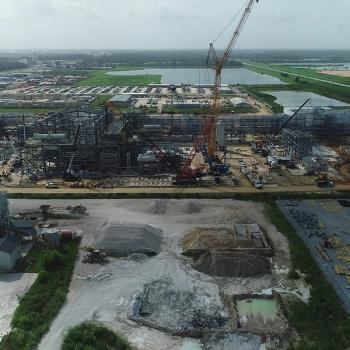
Practical issues in steam turbines used in oil and gas applications
As discussed in earlier sections steam turbine auxiliaries need to be located relative to each other to ensure proper overall functioning. For instance, it is recommended that the oil system is located at a lower level relative to the steam turbine to ensure lube oil return to tank by gravity. If the oil system is at the same level with the steam turbine, then the return line shall respect a certain slope (4%). Run down tank shall be located at higher level than the steam turbine to ensure sufficient static oil pressure to the bearings during coast down.
This article contains excerpts from the paper, "Tutorial on large steam turbine systems in oil and gas applications," by Mounir Mossolly, Emmanuel Bustos and Guillaume Herve at the 2017 Turbomachinery Symposium.
Oil mist eliminator needs to be located at higher level than the lube oil console to ensure drainage of recovered oil back to the oil tank by gravity. Jacking oil pumps (skid) need to be located as close as possible to the shaft line to avoid safety issues of extended piping network of small bore piping at very high pressure that may have risks of rupture. On the other hand, the main condenser in oil & gas applications is located below the steam turbine for compactness purpose. And condensate pumps shall be located at a sufficient level below the condenser to maintain the necessary NPSH margin which is critical for the operation of the pumps.
It is recommended to install the gland steam condenser at a lower level relative to the steam turbine; though it is not absolutely mandatory. However, the condensate tank that collects the condensates from the steam gland condenser shall be located under the steam gland condenser to ensure condensate drainage flow by gravity.
Precautions for Offshore Applications
In offshore applications, the modular structures accommodating the steam turbine systems and other balance of plant equipment are very congested and space availability is very scarce. In such consideration, the most complex installation is for a condensing type steam turbine, which requires in addition to all the auxiliaries required for the back-pressure turbine full condensate and vacuum systems. Condensing type steam turbines are very usual for high power applications. However, for low power applications, it is recommended to have a backpressure steam turbine to avoid numerous auxiliaries that are required for the condensing type steam turbine. In addition to space constraints, site conditions such as wind load and sea motions need to be well adapted in the design. Sea motions are repetitive and returning; every 8 to 15 [seconds], inducing fatigue issues. Sea motions also cause deflections in decks causing relative displacements between fixed points. Accordingly, the design of the steam turbine and all its auxiliaries need to be comprehensive.
In contrast to onshore applications, sea motions need to be compensated in offshore applications by further increasing the slopes of interconnecting piping. One important example is the return oil line from the steam turbine to the lube oil tank, which needs to be properly sloped so that the oil can return from the steam turbine bearing house to the oil tank under the gravitational force at the maximum roll and pitch conditions. The slope shall be increased to cater for worst sea motion condition for which the package need to be in operation.
Noise Emissions and Mitigations
Large steam turbines are noisy machines with sound pressure levels exceeding long term exposure limits. Accordingly, noise attenuation technologies need to be applied and the area around the steam turbine need to be acoustically restricted without hearing protection. Noise emissions from large steam turbines can be attenuated by adding an acoustic enclosure, however this option adds execution complexity for the package. In addition, a noise enclosure will have an adverse effect on the availability of the steam turbine because of spurious or factual trips generated by high temperature and/or gas detection inside the enclosure.
Noise enclosure will also restrict mechanical handling flexibility, so the noise enclosure need to be designed in a way to be partially dismantled (and remain rigidly supported) during heavy mechanical handling such as rotor replacement. It shall be noted that ventilation fans that need to be installed for the enclosure of the steam turbine to dissipate heat by continuous air change-over are also noisy, and the overall noise levels need to be studies before deciding to have the noise enclosure. An alternative to the noise enclosure is to add noise barriers/ walls around the steam turbine (no roof), but this solution is less attractive in offshore projects which use modular design, because the upper deck will be affected by the noise from the steam turbine.
Another alternative is to have an acoustically restricted area around the steam turbine; operators/ technicians are not allowed to access this area without hearing/ ear protection. Acoustic blankets on the steam turbine are also another solution, however corrosion issues under the blankets need to be well investigated according to site conditions. Human factors and Safety Design Steam turbine systems are characterized by extended area of hot surfaces of various equipment which requires personnel protection.
Any surface which is above 60[°C] need to be isolated either by insulation or by a mechanical barrier such as a metallic mesh to avoid operators being in direct contact with the hot surface. Another important aspect in the design is to avoid threaded connections on high pressure and high temperature steam lines and pressure retaining parts by using flanged connections instead; which would provide better sealing. Threaded connection also need to be avoided for the oil (lube and control) piping which can easily lead to oil fires in case of leakage and contact with the hot turbine surface. In some applications the control oil used is different than the lube oil and can be even more inflammable.
Newsletter
Power your knowledge with the latest in turbine technology, engineering advances, and energy solutions—subscribe to Turbomachinery International today.




